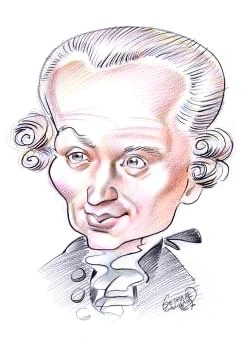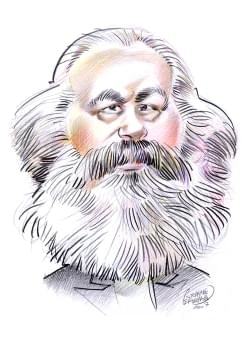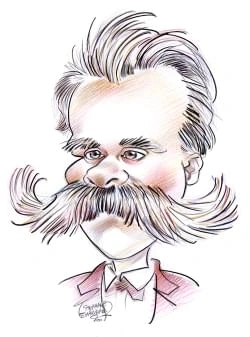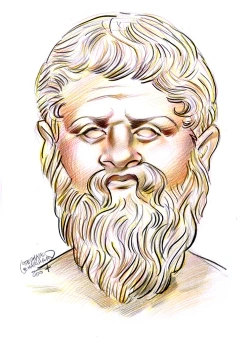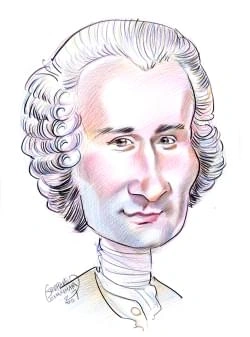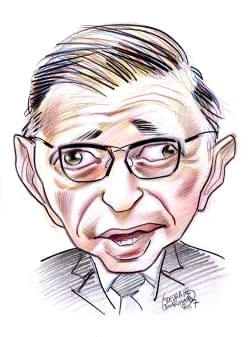51 résultats pour "michelangelo"
-
Michelangelo.
(17 ft) tall, was carved from a block of stone that another sculptor had left unfinished. Michelangelo drew on the classical tradition in depicting David as a nude,standing with his weight on one leg, the other leg at rest ( see contrapposto). This pose suggests impending movement, and the entire sculpture shows tense waiting, as David sizes up his enemy and considers his course of action. While David reveals Michelangelo's expert knowledge of anatomy (he had been dissecting corpses for about...
-
Michelangelo
I
INTRODUCTION
Michelangelo (1475-1564), Italian painter, sculptor, architect, and poet whose artistic accomplishments exerted a tremendous influence on his contemporaries and on
subsequent European art.
(17 ft) tall, was carved from a block of stone that another sculptor had left unfinished. Michelangelo drew on the classical tradition in depicting David as a nude,standing with his weight on one leg, the other leg at rest ( see contrapposto). This pose suggests impending movement, and the entire sculpture shows tense waiting, as David sizes up his enemy and considers his course of action. While David reveals Michelangelo's expert knowledge of anatomy (he had been dissecting corpses for about...
-
Michelangelo - KUNSTLER.
Um 1535 wandte sich der alternde Künstler erneut dem Thema der Pietà zu. Die 1535 begonnene Arbeit an dem für einen Altar vorgesehenen Werk gab er indessen 1550 endgültig auf (heute Museo dell’Opera del Duomo, Florenz). 1555 bis 1564 folgte die (ebenfalls unvollendete) Pietà Rondadini (Castello Sforzesco, Mailand), sein letztes Werk als Bildhauer, an dem er bis unmittelbar vor seinem Tod tätig war. Die letzten, im Auftrag Papst Pauls III. geschaffenen Fresken waren Die Bekehrung des Saulus...
-
Antonioni, Michelangelo - réalisateur de cinéma.
Antonioni (Michelangelo), l'Avventura « J'ai été frappé par la fragilité des rapports humains, par l'instabilité morale, politique et même physique du monde contemporain où la physique devient métaphysique » a déclaré MichelangeloAntonioni à propos de l'Avventura (« chaque jour, nous vivons une aventure idéologique ou sentimentale »), œuvre majeure du cinéma moderne et clé de voûte du style et de l'univers ducinéaste italien dont c'est le quatrième long métrage.Ci-contre, Claudia (Monica Vitti)...
- Rossi Michelangelo, surnommé Michelangelo del Violino.
- Antonioni, Michelangelo - littérature.
-
Antonioni (Michelangelo)
Powered by TCPDF (www.tcpdf.org)\HDLN0000100061 \LINK0008200086PE_0170T Antonioni Michelangelo Cinéaste italien * 29.9.1912, Ferrare Assistant de Marcel Carné, puis réalisateur de documentaires et scénariste, Antonioni aborde le long métrage de fiction en 1950 ("Chronique d'un amour"), avant de rencontrer un succès considérable dans les années 60. "L'Avventura" (1960), "La Nuit" (1961, Ours d'Or au festival de Berlin), "Le Désert rouge" (1964, qui marque l'introduction des premiers effets spécia...
- Pietà by Michelangelo - art.
-
- PROFESSION : REPORTER DE MICHELANGELO ANTONIONI
- PROFESSION : REPORTER MICHELANGELO ANTONIONI/ITALIE-FRANCE/1974 (analyse du film).
- Avventura, l' [Michelangelo Antonioni] - analyse du film.
- Cri, le [Michelangelo Antonioni] - analyse du film.
- Chronique d'un amour [Michelangelo Antonioni] - analyse du film.
- Blow up [Michelangelo Antonioni] - analyse du film.
- Désert rouge, le [Michelangelo Antonioni] - analyse du film.
- L'ÉCLIPSE MICHELANGELO ANTONIONI/ITALIE/1962 (analyse du film).
-
- L'AVVENTURA de MICHELANGELO ANTONIONI
- L'ÉCLIPSE de MICHELANGELO ANTONIONI
- LA NUIT de MICHELANGELO ANTONIONI
- L'AVVENTURA MICHELANGELO ANTONIONI/ITALIE-FRANCE/1960 (analyse du film).
-
Histoire des Arts. Judith décapitant Holopherne De Michelangelo Merisi da Caravaggio
Judith décapitant Holopherne , 1598 , huile sur toile, 145 × 95 cm , Rome, Galerie nationale d'art ancien
- Pistoletto, Michelangelo - arts plastiques.
- Michelangelo's David - arts.
- Antonioni Michelangelo
-
- Antonioni Michelangelo, né en 1912 à Ferrare, cinéaste italien.
- Michel-Ange (Michelangelo Buonarroti.
- Caravage (Michelangelo Merisi ou Amerighi.
-
Renaissancekunst.
2.3 Die zweite Künstlergeneration In den folgenden Jahrzehnten wurden die für die Renaissancekunst typischen Neuerungen wie perspektivische und Landschaftsdarstellung, neue Figurenauffassung undminutiös geplante Bildkompositionen weiterentwickelt und verfeinert. In Florenz beschäftigten sich Künstler wie Antonio Pollaiuolo und Andrea del Verrocchio anhand vonStudien am lebenden Modell mit der komplizierten Anatomie des Menschen. Sie fanden ihren Niederschlag in Bildern wie Pollaiuolos Martyriu...
- Michelangelo Buonarroti, dit Michel-Ange (Dates)
-
Renaissance Art and Architecture
I
INTRODUCTION
Renaissance Composition
During the Renaissance (15th and 16th centuries) artists discovered new ways to help them create more realistic and
compelling images.
with reliefs, had been familiar for centuries. A Early Renaissance Sculpture Ghiberti’s Gates of ParadiseThe Gates of Paradise are bronze doors created by Italian Renaissance sculptor Lorenzo Ghiberti between 1425 and 1452for the east entrance to the baptistery of the Florence Cathedral in Italy. This detail, showing Isaac and Esau, is from oneof the doors' ten panels, each of which illustrates a story from the Bible. Ghiberti endowed the scenes with volume, depth,and movement, and helped initi...
- Michelangelo Antonioni Ingmar Bergman Federico Fellini
-
Italienischer Film.
Democrazia Cristiana bei den ersten demokratischen Wahlen 1948 zum Auseinanderbrechen der antifaschistischen Einheitsfront, die den gemeinsamen ideologischenNenner auch für den Neorealismus gebildet hatte. In den beginnenden fünfziger Jahren reklamierte die Linke das neorealistische Kino für sich und warf Roberto Rossellininach der Entstehung von Stromboli, terra di dio (1949/50; Stromboli ), Francesco, giullare di dio (1950; Franziskus, der Gaukler Gottes ) und Viaggio in Italia (1953;...
-
- CARAVAGE Michelangelo Merisi, dit : La Conversion de Saint Paul (analyse du tableau).
- CARAVAGE Michelangelo Merisi, dit le Jeune Bacchus malade (analyse du tableau).
- CARAVAGE Michelangelo Merisi, dit Caravaggio, dit Le : Les Oeuvres de la Miséricorde (analyse du tableau).
-
Analyse du tableau de Michel-Ange, Michelangelo Buonarroti, dit : La Sainte Famille
Le thème de la Sainte Famille est en harmonie avec la circonstance pour laquelle le tableau fut peint, c'est-à-dire lemariage entre Agnolo et Maddalena Doni. La Vierge est assise par terre, selon une iconographie d'origine médiévale qui représentait Marie comme Madone del'humilité. La composition est très dynamique : la Vierge est représentée au moment où elle reçoit l'Enfant Jésus des mains deJoseph. Aussi bien le corps de la Vierge que celui de l'Enfant sont caractérisés par une forte muscu...
- Caravage (Michelangelo Merisi, dit le) Peintre italien (Porto Ercole, prov.
-
Rom - geographie.
eingerichtet und bildet heute neben den Vatikanischen Museen eine der bedeutendsten Kollektionen der Stadt. Das Nationalmuseum Villa Giulia mit einer herausragendenSammlung etruskischer und römischer Kunst ist in dem Mitte des 16. Jahrhunderts erbauten Landhaus von Papst Julius III. untergebracht. Die Galleria Borghese mit Malereiund Plastik befindet sich in einem Palast aus dem frühen 17. Jahrhundert und geht auf die Kunstsammlung der gleichnamigen Familie zurück. Im Museo Nazionale Romanodelle...
-
Baroque Art and ArchitectureIINTRODUCTIONGerman Baroque ArchitectureThe baroque style of architecture flourished in Germany in the 18th century.
C Early baroque styles Conversion of Saint PaulItalian baroque painter Caravaggio painted scenes of realism and drama, often selecting lofty, religious themes anddepicting them with lower-class characters and settings with dramatic spotlighting. With its unidealized characters andfocus on the horse’s body, his Conversion of Saint Paul seems to record a stable accident, not a miraculous conversion byGod. This work was painted in 1601 and is in the Cerasi Chapel, Santa Maria del Popolo, Rome, It...
-
Rome (Italy) - geography.
country’s best, and in the summer at the Baths of Caracalla. The city also has some 20 theaters and 6 major concert halls, which offer a varied repertory during the fall,winter, and spring. The museums of the city deal with all aspects of the arts and sciences and are among the world’s finest. The oldest art collection in Rome, housed in the CapitolineMuseum, was established in 1471 and contains exceptional antiquities. Among other Roman museums are the National Museum of the Villa Giulia, which...
-
-
Renaissance
I
INTRODUCTION
Renaissance, series of literary and cultural movements in the 14th, 15th, and 16th centuries.
the great writings of ancient Greece and Rome. Intellectuals continued to build on the ideas of the Renaissance during the 18th century Age of Enlightenment, a time when scientific advancements led to a newemphasis on the power of human reason. One of the early Enlightenment thinkers was French philosopher and writer Voltaire. He claimed that the Renaissance was acrucial stage in liberating the mind from the superstition and error that he believed characterized Christian society during the Middl...
-
Renaissance .
the great writings of ancient Greece and Rome. Intellectuals continued to build on the ideas of the Renaissance during the 18th century Age of Enlightenment, a time when scientific advancements led to a newemphasis on the power of human reason. One of the early Enlightenment thinkers was French philosopher and writer Voltaire. He claimed that the Renaissance was acrucial stage in liberating the mind from the superstition and error that he believed characterized Christian society during the Middl...
-
néoréalisme.
Le cinéma italien revint à ses fastes d'antan. On trouva cependant encore quelques traces de néoréalisme dans les films de nouveaux venus, formés à son école : Federico Fellini ( la Strada , 1954), Michelangelo Antonioni ( le Cri , 1957), Pier Paolo Pasolini ( Accatone , 1961), et, plus tard, Francesco Rosi et Ermanno Olmi. À partir des années soixante, le néoréalisme se trouva du côté de la Nouvelle Vague française, du cinéma québécois, du « cinema novo » brésilien et des adeptes du « cinéma...
-
Titian.
Flaying of Marsyas (circa 1570-76, Kroměříž, Czech Republic) and the Nymph and Shepherd (circa 1574, Kunsthistorisches Museum). Here colors are more subdued, but the turbulence of the brushwork, hardly matched again until 20th-century painting, almost submerges the form entirely. These late mythological paintings, whichTitian called poesie (poems), stand among the most formidable statements ever made of the irresistible, elemental powers of nature. These works are paralleled by a sequence...
-
Toutes les expressions artistiques - arts plastiques, architecture, musique, littérature -
sont concernées par le mouvement baroque, qui s'est étendu à tous les pays catholiques en
leur donnant parfois leurs plus grands chefs-d'oeuvre.
Michel-Ange (Michelangelo Buonarroti, dit) Pierre de Cortone (Pietro Berrettini, dit Pietro da Cortona, en français) Pozzo (Andrea, dit le Père) Raphaël (Raffaello Santi ou Sanzio, dit en français) Renaissance - Les principes artistiques de la Renaissance Rome - Arts - Les beaux-arts - La Rome chrétienne Saint-Pierre de Rome Tiepolo Titien (Tiziano Vecellio, dit en français) trompe-l'œil Véronèse (Paolo Caliari, dit Paolo Veronese, en français) Les livres sculpture - la Bienheureus...
-
CARAVAGE Michelangelo MERISI, dit: La Cène à Emmaüs
CARAVAGE Michelangelo MERISI, dit La Cene a Emmaiis Ne a Caravaggio, 1573 Mort a Porto Ercole, 1610 A la fin des annees 1590, Caravage obtient ses premieres commandes publiques a l'intention des chapelles Contarelli, et Cesari a Rome. Desormais reconnu des amateurs, ses oeuvres montrent le souci de proclamer sa parfaite connaissance de la tradition classique. La Cene a Emmaus, sans doute peinte vers 1600, manifeste sa maturite stylistique, qui aboutit a la transposition des episodes sacres dans...
-
Titian
I
INTRODUCTION
Titian (1477?
Pesaro (1519-26), Titian effected a crucial change in Renaissance sacre conversazioni (paintings of the Virgin enthroned among saints) by placing the Virgin, traditionally at the composition's center, halfway up its right side, and by painting behind her in diagonal recession two giant columns that soar out of the picture'sspace. This new scheme was widely adopted by later artists, such as Paolo Veronese and the Carracci family, and, with its evocation of movement and infinity, it openedthe w...
-
Barock (Kunst und Architektur).
Longhenas Santa Maria della Salute (begonnen 1631) zeichnet sich durch ihr extravagantes Äußeres und ihre exponierte Lage am Eingang des Canal Grande aus. GuarinoGuarini versah die Cappella della Santa Sindone (Kapelle des Heiligen Grabtuches, 1667-1694) in Turin mit einer hohen Kuppel, deren ausgeklügelte geometrische Formenauf islamische Vorbilder zurückgehen. 4 SPANISCHER BAROCK 4.1 Spanische Barockmalerei Vincente Carducho aus Florenz trug dazu bei, in Spanien einen antimanieristischen Mal...
-
-
MICHEL-ANGE (Michelangelo Buonarroti, dit): La Création d'Adam
MICHEL-ANGE (Michelangelo Buonarroti, dit) Né à Caprese, La Création d'Adam près d'Arezzo, 1475 Mort à Rome, 1564 En 1508, le pape Jules II, toujours soucieux de rendre à Rome sa splendeur passée, obligea Michel -Ange à décorer la voûte bleue constellée d'étoiles d'or de la chapelle construite par le pape Sixte IV dans l'enceinte du Vatican . L'artiste s 'enferma et, pratiquement sans aide, acheva en quatre ans une œuvre titanesque , co...
-
Peter Paul Rubens
I
INTRODUCTION
Thetis Dipping Achilles in the Styx
The sea nymph Thetis is seen dipping her son Achilles in the River Styx to make him immortal.
Rubens, Equestrian Portrait of the Duke of LermaIn 1603 Flemish painter Peter Paul Rubens traveled to Spain as part of a diplomatic mission. While there, he received acommission for this portrait of the Duke of Lerma, the powerful prime minister of Spanish king Philip III. The painting nowhangs in the Prado Museum in Madrid, Spain.The Prado Museum, Madrid/Archivo Fotografico Oronoz Shortly thereafter, following the example of many northern European artists of the period, Rubens traveled to Italy...
}})


